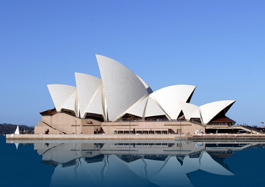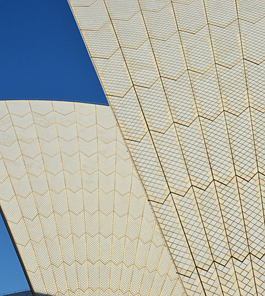
<div> The Opera House has been standing in the harbor of Sydney, Australia for 40 years. </div>
 |
The first piece performed here was War and Peace by the Russian composer, pianist, and conductor Sergei Prokofiev. A master of musical modernism, whose works are among the peaks of 20th-century music, composed this opera between 1941 and 1943. The adaptation of Leo Tolstoy's famous novel was an expression of the composer’s deep patriotism. The orchestra at the first performance in the Sydney Opera House was conducted by Edward Downes.
Since then, a number of outstanding artists have performed here. Among others, Leonard Bernstein conducted the New York Philharmonic Orchestra here in 1974, Luciano Pavarotti performed in a charity gala concert in 1983, and in 1996 Michael Jackson received an award from Sony Music along with a one-ton statue that greeted him from a raft on the bay's surface.
 |
Among the famous personalities who honored the opera with their visit were British Queen Elizabeth II, Pope John Paul II in 1986, South African President Nelson Mandela four years later, U.S. President Bill Clinton in 1996, and in the following year, for example, German Chancellor Helmut Kohl.
The architect of the building, Danish architect Jørn Utzon, was reportedly inspired by palm leaves and other motifs from nature as well as from the history of architecture. The charm of his visionary work is enhanced by its surroundings - it stands at the very end of the Bennelong Peninsula, next to a botanical garden that creates a green background for the white shell-like shells, while the bay provides an important blue horizontal and the nearby bridge offers an impressive compositional relationship.
Utzon spent a total of eight years working on this challenging project and in 2003 he was awarded the Pritzker Prize (considered the Nobel Prize for architecture) with the words: "Utzon demonstrated that a beautiful and seemingly impossible goal can be achieved in architecture."
With his revolutionary project, Utzon succeeded among 233 proposals in an architectural competition in 1957. By then he was already among the world's most famous architects with a distinctive style combining monumentality with harmony.
"There will be two buildings visibly suspended on shells like pieces of furniture," he declared about his work in 1962. The most distinctive element of the building became precisely these shells covered with light glazed and matte ceramic tiles.
Today, the entire complex consists of five separate spaces: a concert hall, the actual opera house, a drama theater, a playhouse, and a studio. The studio opened in 1999 and is mainly dedicated to experimental creations.
The Sydney Opera House has become a symbol of Australia and was registered as a UNESCO World Heritage Site in 2007.
The English translation is powered by AI tool. Switch to Czech to view the original text source.
0 comments
add comment
Related articles
0
01.03.2019 | Sixty years ago, the iconic Sydney Opera House began to be built
1
08.10.2018 | Australians do not want a billboard on the Sydney Opera House
0
14.05.2017 | Next week, the modernization of the Sydney Opera House will begin
0
12.08.2016 | Opera in Sydney will undergo renovations to improve acoustics
2
11.12.2013 | Opera in Sydney is selling tiles from the roof on the internet
1
02.03.2009 | Fifty years ago, the foundation stone of the Sydney Opera House was laid
0
19.10.2008 | The impressive Sydney Opera House was opened 35 years ago












